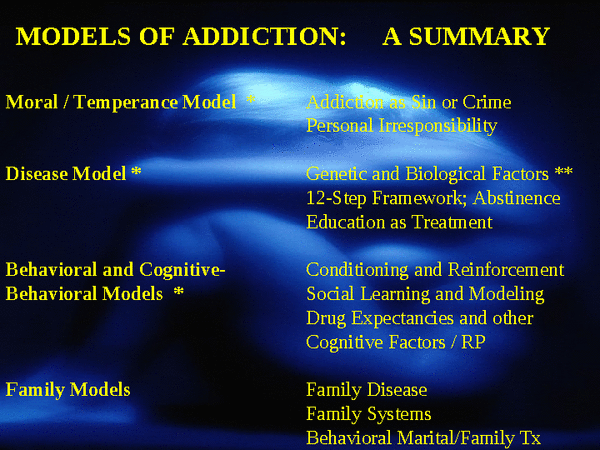The therapist can mention that the body operates relatively effectively to rid itself of moderate amounts of psychoactive compounds. Nevertheless, excessive usage can harm organs and their communicating functions to the point of adding to major illness, including cardiac and pulmonary effects, weight management problems, and neurological and mental disorders, to name a few.
Once again, the client's interpretation of this tradeoff might differ extensively from the therapist's, so the therapist intervenes most successfully when equipped with both an open mind and the capability to assert clear, accurate details. Also, considering that clients are rather varied in their opinions and analyses of the threats and advantages of substance use because of psychoeducation about drug effects, the therapist remains mindful and responsive to the private client's perspective and cultural norms (why aren't addiction treatment centers federally regulated).
Even when the customer acknowledges the risky nature of substance use, the client for whom substance usage concerns have actually emerged in treatment likewise normally expresses some dream to continuing use to obtain the advantages regardless of the threats, even significant ones. A psychoeducational stance permits the therapist to remain more neutral while still triggering evaluation of various angles on the topic.
The body has natural mechanisms for getting reward and decreasing damage from interactions with the environment, consisting of the consumption of exogenous psychoactive substances. Together these 2 sets of biological functions reinforce the likelihood that a person will continue using drugs or alcohol. The therapist generally wishes to interact that if changes caused in the body by drugs are preserved over a long period of time by repeated substance abuse, the potential for harmful repercussions continues to increase.
Nevertheless, the quick actions and euphoric results of drugs with high addiction possible supply strong gratification that can overshadow the user's interests in non-drug activities and awareness of postponed expenses of compound use. Outcomes like tolerance and withdrawal can promote the user to participate in more frequent administration of higher quantities of drugs.
What Does What Ar Esome Treatment For Exercise Addiction Mean?
Therapists can assist compound using clients to identify the qualities of withdrawal, tolerance and dependence. Substance withdrawal. Relating to withdrawal, some customers may not be mindful that specific signs they experience are attributable to the chemicals they are ingesting. Therapists can assist educate such clients to the signs usually associated with the particular drugs the client has utilized (or has an interest in utilizing).
Other clients are acutely familiar with their substance withdrawal signs, however say they have actually learned to deal with them or do not think there is much they can do about them. Still others believe they are funny, all just part of an excellent night on the town. Whatever the customer's viewpoint, the therapist motivates the customer to elaborate, and after that to consider possible interventions to attend to the client's own symptoms.
With regard to tolerance, the therapist notifies the customer that simply because the user's experience of a drug's results is lessened as tolerance establishes, it does not mean the prospective or actual damage is lowered. In fact, while tolerance does not ensure problems, it might well increase the severity of an addictive disorder, particularly personallies who are genetically, medically, or psychologically Drug Rehab Center vulnerable.
Some clients who use compounds clearly take pride in their high tolerance for their drugs of option (what order do you do addiction treatment). Attempting to persuade a customer this is risky will probably just raise resistance. However a psychoeducational intervention facilitates equivalent consideration of different viewpoints on the exact same subject, consisting of awareness of factors to feel casual or smug in addition to reasons to be worried about customers' reported abilities to handle themselves when intoxicated.
Dependency. Compound reliance, a term familiar to readers of the DSM-IV, was often corresponded with dependency, however the term "Compound Dependence" was eliminated from the DSM-5, in efforts to improve identify and streamline its description. The DSM-5 still describes "Substance-related and addictive disorders" in the basic heading for the entire diagnostic classification, while the severity of the disorder is now explained in regards to the variety of symptoms reported or exhibited by the client.
https://transformationstreatment.weebly.com/blog/alcohol-addiction-delray-beach-florida-transformations-treatment-center style="clear:both" id="content-section-2">Some Known Factual Statements About What Ar Esome Treatment For Exercise Addiction

Firstly there is terrific confusion in the public, the media, and even among researchers and professionals about how to differentiate chemical dependency from typical, unproblematic compound usage. Terminology, explanations, and ramifications vary extensively throughout persons utilizing them. The therapist designs flexibility through desire to honestly acknowledge different, even conflicting viewpoints as they emerge.
Second, lots of compound users fear or feel bitter the label of dependency, and might have little desire to go over or find out about it. An advantage of a psychoeducational technique is the capability to present material in an abstract or gotten rid of style, even with a specific declaration that the information might or might not pertain to the customer.

Clients might offer remarks about their own situations in action to learning generalized material, or they may soak up info the therapist shares without explaining in words a response. The attentive therapist watches and listens for the client's nonverbal as well as spoken responses to psychoeducational material. A facial expression, a modification in body posture, or a wordless sigh or groan each acts as hints for the therapist to welcome comment. Therapists can offer methods and clarify procedures by which clients can actively participate in deliberate modification processes. Clients regularly benefit from a therapist's guidance relating to identification and weighing of alternatives, selection from among options, and execution of brand-new strategies through routine practice. Especially because lots of people who fulfill criteria for compound usage conditions have actually over-learned expectations of immediate satisfaction, therapists likewise need to stress perseverance with the gradual, approximate nature of change.
A therapist can strengthen the client's dedication to decisions to prevent relapse by creating alternative viewpoints and methods to promote healthier coping activities. After clarifying possible barriers to treatment objectives, the customer and therapist expand the regression avoidance strategy by specifying new ways of thinking of problems and concerns, new techniques for managing tough emotions and disruptive behaviors, and brand-new methods for the customer to inhabit time.
Engaging customers in brand-new recreation and helping them establish occupational alternatives is important in planning to prevent relapse. Rewarding abstinence from compound use, both total and partial, and likewise strengthening alternatives to usage of drugs or alcohol are empirically supported methods for increasing inspiration for modification (Miller, 2006). Typical consider effective treatments include improving a customer's behavioral control abilities and changing support contingencies to incentivize abstaining (Carroll and Roundsaville, 2006).